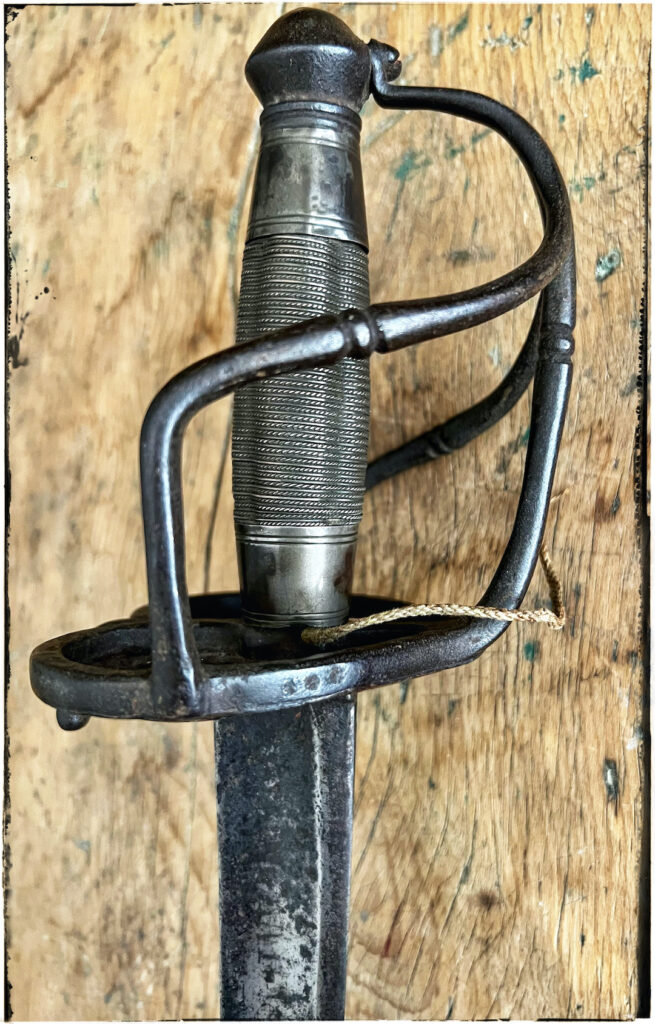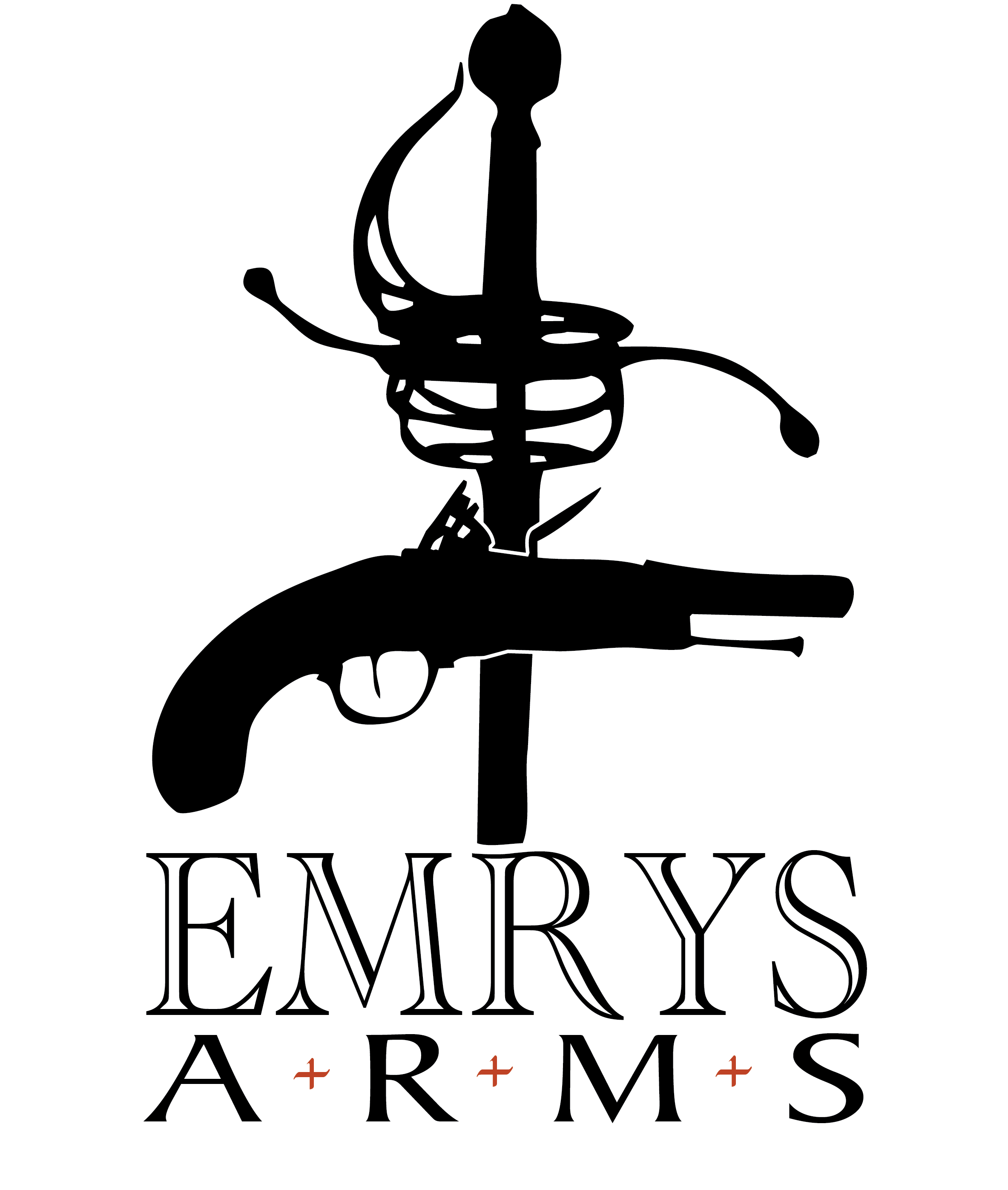| Collection #: | 2020.029 |
|---|---|
| Type: | Backsword of Montmorency type |
| Nationality: | Possibly Spanish or Portuguese |
| Pattern: | Horseman's Sword |
| Date: | Mid-18th Century |
| Hilt: | Walloon Style Hilt |
| Blade Length: | 95cm (37.4") |
| Blade Width: | 3.3cm (1.3") |
| Overall Length: | 110cm (43.31") |
| Maker: | No Legible Maker's Mark |
| Blade Markings: | Draw me not without reason, sheath me not without honour |

A Walloon-style hilted horseman’s backsword which most likely dates to the second or third quarter of the 18th century. Most likely of Spanish or Portuguese origin based on the location the sword originated from and the stylistic elements of the lobes on the mid-point of the guard bars.
It has an almond-shaped pommel. The peening on the top of the pommel has not been disturbed which lends credibility to being the original grip around the handle. The grip appears to be silver. A band of silver sheet wraps around the top ferrule and a band around the lower ferrule. Indented silver twist-wire wraps the section in between. The grip moves slightly as the wood core underneath has shrunk. A short length of an old string is exiting from the bottom of the grip. Is it possibly wrapped as a layer between the wood core and silver twist-wire?
The centre branch of the guard rises from the pierced heart-shaped guard and is fixed to the pommel via a hand-forged screw. The left sidebar rises from the outside left of the guard for 6cm and then abruptly bends to join with the centre guard right above the lobe at the midpoint. The left bar has a decorative lobe at its midpoint after the bend which mimics the motif in the main guard. The right side is a mirror image of the left, with an additional bar. The additional bar, which would provide additional hand protection on the outside away from the body, rises straight up from behind the sidebar and is attached to the pommel via another hand-forged screw.
The frame of the heart-shaped guard is quite thick. The thin plates on the interior have been punched with small holes and appear to be spot welded in some fashion to the bottom of the guard. Scratched into the right side of the heart-shaped guard are the numbers 1 7 4 1. It is possible that this is a date, as it would line up with the rough era that this style of blade started to come into use, but, as pointed out to me by another collector, they could also be mystical numbers. On older blades (often it seems in the 17th and early 18th century) it is not uncommon to find certain sets of numbers etched into them. The meanings for the number combinations seem to be lost, but 1741 is a number known to be on some blades – although I have never personally seen it on a hilt before.
The small quillon exits from the top of the heart-shaped guard and then bends abruptly at a 90-degree angle. It contains the same lobe motif as on the guard bars.
The blade is quite long, which is why I have classified this as a horseman’s sword – the ability to reach out and touch someone would be quite easy. The setup of the fullers on the blade would lean towards classifying it as a Montmorency Style blade. A key indicator of a Montmorency-style blade is the second (and thinner) fuller nested in between the main fuller and the spine of the blade. The blade has some minor pitting and has darkened with age. There is an inscription on both sides of the blade that can be seen – with some difficulty. The inscription is in Latin and reads on one side “Draw me not without reason” and on the other side “Sheath me not without honour”.
I want to say that this sword is closer to 1700 for a few reasons. The ageing of the metal on the guard seems very similar to that of several 17th-century swords in the collection. This style of hilt was in use in the second half (at least) of the 17th century in Northern European areas (perhaps others) and was exported to other areas. The use of hand-forged screws to secure the guards to the pommel was gradually replaced with guards that fit into slots in the pommel (without the use of screws). And the use of mystic numbers (if that is what they are) on the hilt.
However, I cannot recall any examples of swords that use Montmorency-style blades earlier than maybe the second quarter of the 18th century. Earlier versions of this style guard typically have more pronounced decorative lobes – though this could be explained by regional styles. Also, the guard lacks a specific rounded thumb guard which began to disappear in later variations of this style of hilt.
Therefore, it only seems logical to place this sword as mid-18th century with a little wiggle room for movement on either side of that date until such time as additional information comes to light.
Aside from Generic Walloon sword information, no books were available to consult on this sword. A general consensus was accepted on an international forum, that it was stylistically of Spanish or Portuguese origin. The decorative lobes on the guards are somewhat similar to those found on Spanish rapier guards with the guard lobe decoration swelling just slightly before they meet and a separate swelled area between the two lobes.
For a further discussion on Walloon style hilts.
There are currently no known photographic examples that I am aware of, but they will be added if any come to light.
We use cookies to improve your experience on our site. By using our site, you consent to cookies. Enjoy the cookies...they're delicious...
Websites store cookies to enhance functionality and personalise your experience. You can manage your preferences, but blocking some cookies may impact site performance and services.
Essential cookies enable basic functions and are necessary for the proper function of the website.
Statistics cookies collect information anonymously. This information helps us understand how visitors use our website.
Google Analytics is a powerful tool that tracks and analyzes website traffic for informed marketing decisions.
Service URL: policies.google.com

